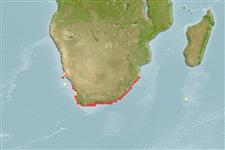Common names from other countries
Environment: milieu / climate zone / depth range / distribution range
Ecología
marino; agua dulce; salobre. Subtropical; 27°S - 35°S
Southeast Atlantic: restricted from Lüderitz, Namibia to northern Natal, South Africa.
Length at first maturity / Tamaño / Peso / Age
Maturity: Lm 4.0 range ? - ? cm
Max length : 11.0 cm SL macho / no sexado; (Ref. 7248)
Espinas dorsales (total): 6 - 9; Radios blandos dorsales (total): 115; Espinas anales 1; Radios blandos anales: 15 - 18. Body silvery and translucent with a midlateral band; dusky upper surface (Ref. 4125).
Forms schools along the coast and in estuaries, especially during spring (Ref. 3302). Also found in coastal lakes (Ref. 7248). Small individuals filter out small organisms such as phytoplankton and rotifers. Above 3.5 cm TL, it feeds mostly on crustaceans especially amphipods taken from the water column as well as off the bottom. Preyed upon by fishes and birds (Ref. 7248).
Life cycle and mating behavior
Madurez | Reproducción | Puesta | Huevos | Fecundidad | Larva
Skelton, P.H., 1993. A complete guide to the freshwater fishes of southern Africa. Southern Book Publishers. 388 p. (Ref. 7248)
IUCN Red List Status (Ref. 130435)
CITES (Ref. 128078)
Not Evaluated
Threat to humans
Harmless
Human uses
Pesquerías: pesquerías de subsistencia; carnada: usually
Más información
ReferenciasAcuiculturaPerfil de acuiculturaRazasGenéticaElectrophoresesheritabilidadEnfermedadesProcesamientoMass conversion
ColaboradoresImágenesStamps, Coins Misc.SonidosCiguateraVelocidadTipo de nataciónSuperficie branquialOtolitosCerebrosVisión
Herramientas
Special reports
Download XML
Fuentes de Internet
Estimates based on models
Preferred temperature (Ref.
115969): 14.3 - 23.9, mean 19.5 (based on 14 cells).
Phylogenetic diversity index (Ref.
82804): PD
50 = 0.5312 [Uniqueness, from 0.5 = low to 2.0 = high].
Bayesian length-weight: a=0.00776 (0.00426 - 0.01415), b=3.14 (2.97 - 3.31), in cm Total Length, based on LWR estimates for this species & (Sub)family-body (Ref.
93245).
Nivel trófico (Ref.
69278): 3.4 ±0.46 se; based on food items.
Resiliencia (Ref.
120179): Medio, población duplicada en un tiempo mínimo de 1.4-4.4 años (Preliminary K or Fecundity.).
Fishing Vulnerability (Ref.
59153): Low vulnerability (10 of 100).
